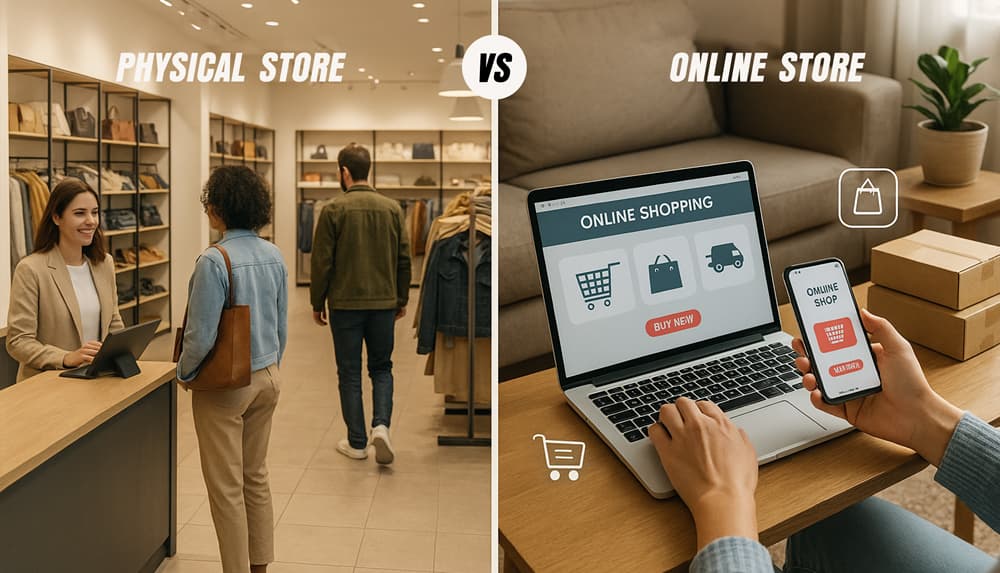Physical Store Vs Online Store: The Pros and Cons

In the fast-changing world of retail businesses are always looking to determine the best method to contact their customers and generate sales. In the past, the ability to sell relied on a physical store; brick-and-mortar location; location, where a customer would come to a physical place in order to browse, pick out, and purchase products or services.
Now, with the internet and e-commerce, a new way to sell has emerged as a strong alternative or supplemental manner of selling. Both have their negative and positive aspects, and understanding the difference is important for businesses of any kind, whether it be a start-up or established business.
In this comprehensive analysis, we'll examine the key Pros and Cons of each approach, helping you determine which path aligns best with your business goals, target audience, and available resources by eCommerce website design company India.
I. Physical Store: Traditional Retail
The physical store or brick-and-mortar store is the traditional method of selling, where the customer goes to a physical place to browse, pick, and purchase products or services.
Pros of Physical Store:
Sensory Experience and Interaction with Product:
Intangibility: Customers can touch, feel, try on, smell and see the products before they purchase them; suppose a customer is deciding between several pairs of shoes or several couches. or a new set of tire. Visual, tactile, and sensory input has an important role to play in deciding which to purchase.
Lower Returns: Being able to personally inspect an item tends to produce greater customer satisfaction and much lower rates of return than with an online purchase, as shoppers are more than aware of what they're receiving.
Instant Gratification:
Shoppers are able to buy an item and bring it home instantly, satisfying an immediate want or necessity. This "instant gratification" component is a strong motivator for impulse buying and instant needs.
Personalized Customer Service and Interaction:
Face-to-Face Support: Sales representatives can make custom suggestions, respond to questions on the spot, show product use, and present customized solutions. This in-person human communication can establish stronger customer relationships and trust.
Relationship Building: Regular consumers can have a relationship with employees, creating loyalty and a feeling of belonging. This human connection is hard to establish online.
Trust and Credibility:
A physical presence tends to carry an instantaneous sense of legitimacy and trustworthiness with it. Customers are able to view the store, its employees, and its stock, which can be a reassuring factor, particularly for new or smaller brands.
Easy Returns and Support: Processing returns, exchanges, or customer service problems in person can be faster and easier for both the business and the customer.
Impulse Purchases and Upselling/Cross-selling Opportunities: The product placement, store layout, and friendly staff can assist in promoting impulse purchases. Product placement strategy and suggestive selling by employees prove to be incredibly effective in terms of boosting average transaction value.
The customers may find products they were not seeking consciously just by Browse.
Community Hub and Local Presence:
Physical stores can become common gathering centers, hosting events, workshops, or even just providing a space for socialization. They add to the local economy and can leverage local foot traffic and community loyalty.
Disadvantages of Physical Stores:
High Overhead Expenses:
Rent/Lease: Often the greatest cost, particularly in high-traffic areas.
Utilities: Electricity, water, heat, and cooling charges are ongoing.
Staffing: Wages, benefits, and training of sales associates, managers, and security staff.
Inventory Management: Expenses related to storing, protecting, and maintaining physical inventory in the store.
Maintenance & Security: Physical space maintenance, cleaning, repairs, and security measures.
Property Taxes & Insurance: Extra financial responsibilities linked to the physical property.
Geographical Limitations:
A brick and mortar store can only attract customers who are willing and capable of driving to the store's location. This restricts the customer pool heavily to a local or regional market. Expansion involves the opening of new physical stores, which is an expensive and labor-intensive process.
Limited Operating Hours:
Physical stores have set business hours, so customers outside of these hours cannot shop. This may lead to missed sales.
Scalability Challenges:
Growth for a physical retailing business is often a matter of obtaining additional property, adding more people to the payroll, and handling more inventory at multiple sites, which can be difficult and requiring large sums of capital.
Inventory Management Complexity:
Keeping inventory levels among various physical locations, deterring theft, and maximizing shelf space can prove to be difficult.
Lower Sales Tracking & Analytics:
POS systems do offer sales information, but it is harder to gain profound insights into customer Browse behavior, product interaction (without actual buy), and individualized marketing compared to the analytics of online systems.
Related Post: Is Shopify Good for Ecommerce Website? [Pros and Cons]
II. The Online Store: The Digital Marketplace
The e-commerce website or online store enables customers to browse and buy products or services via the internet, from any location with internet access.
Advantages of Online Stores:
Global Accessibility and Unlimited Customer Base:
An online retailer is not geographically constrained. Companies can sell to any customer in the world, multiplying their potential market and client base.
This removes the necessity of having several physical outlets in different areas.
Lower Overhead Costs:
No Rent/Lease: Removes the substantial expense of a physical storefront.
Reduced Staffing: Fewer sales staff; customer service can in many cases be done remotely or through chatbots.
Lower Utilities/Maintenance: Minimal physical presence lessens these recurring expenses.
This leaner cost profile translates into greater profit margins or increased ability to price competitively.
24/7 Accessibility:
Online shops are "open" 24/7, 365 days a year. Customers can shop at their own convenience, in spite of time zones and conventional business hours, resulting in increased sales opportunities.
Scalability and Flexibility:
Scalability of an online business is much quicker and requires less capital. Expanding inventory, introducing new product lines, or entering new markets can frequently be done through software revisions and advertising as opposed to new construction.
Operations of the business can be controlled anywhere with internet access.
Data Analytics and Personalization
Online marketplaces offer dense customer behavior data: what they view, how long they are on pages, what they put in the cart, purchase history, etc. Such data allows for highly targeted marketing campaigns, product suggestions based on customer data, and optimized user experiences, resulting in greater conversion rates and customer loyalty.
Increased Product Offerings:
The Internet-based stores have no physical shelf space constraints. Companies can provide a much wider range of products, such as specialty goods, drop-shipped goods, and intangible products.
Direct Communication and Marketing:
Simple integration with email campaigns, social media marketing, and retargeting ads enables direct and extremely efficient communication with the customer.
Ease of Setup (Relatively):
Though professional development is the best, different platforms such as Shopify, WooCommerce, or Magento make it somewhat easier for a person or small company to start an online store than a physical store.
The eCommerce website development cost in India can be very competitive, making it a viable choice for startups. A minimal e-commerce website with core functionalities (product listings, shopping cart, payment gateway) could begin at ₹50,000 to ₹1,50,000, while more tailored or enterprise-level solutions could go between ₹3,00,000 to ₹15,00,000+ or more, depending on complexity, features, integrations, and the level of expertise of the development agency.
Drawbacks of Online Shops:
Lack of Physical Touch and Sensory Exposure:
Shoppers cannot touch, feel, or physically inspect products prior to purchase. This may be a major impediment for some product types (e.g., clothing, furniture, high-end products). Dependence on pictures, videos, and descriptions might not accurately express product quality or fit.
Shipping Fees and Delayed Deliveries:
Customers must pay to ship (or have the seller absorb this) and wait, potentially an area of annoyance or frustration, particularly for emergencies. Handling logistics, inventory levels (particularly in multiple warehouses), and coordination with shipping carriers can be complicated.
Increased Return Rates:
Because of not being able to see products prior to purchase, returns from online purchases are often substantially higher than from store-based purchases, which raises operational costs for companies.
Intense Competition and Price Sensitivity:
With global reach comes global competition. The customer can compare prices from multiple sellers in seconds with a few clicks, resulting in high price pressure and lower profit margins.
Differentiation in an overcrowded online market demands heavy investment in digital marketing (SEO, SEM, social media advertising).
Trust and Security Concerns
Certain customers remain wary of providing personal and financial data online because of cybersecurity threats (although legitimate sites maintain strong security).
Establishing trust solely by a web presence can be slow and demands ongoing effort in brand establishment and customer support.
Lack of Personal Touch (for certain customers):
As chatbots and AI continue to evolve, however, the lack of direct human communication can be a hindrance to customers who want personalized help or social interaction while shopping.
Technical Glitches and Outages:
An e-commerce website is at risk of website crashes, server malfunctions, payment gateway glitches, or cybersecurity breaches, all of which have direct consequences on sales and customer experience.
III. The Omnichannel Era
More and more companies are understanding that it is not an issue of "either/or" but "both/and." The omnichannel retail approach is a synthesis of both online and offline stores' strengths to provide an integrated and seamless customer experience.
Click-and-Collect (BOPIS - Buy Online, Pick Up In-Store): Consumers buy online and collect from a nearby store, merging convenience with the instant satisfaction.
Showrooming/Webrooming: Consumers go into physical stores to see products ("showrooming") before buying them online (usually getting a better price), or look online ("webrooming") before making the purchase in a physical store. Companies can take advantage of this through competitive pricing or in-store-only perks.
In-Store Technology: Physical stores are incorporating digital features such as interactive kiosks, endless aisle displays (where customers can order out-of-stock products online), and AR/VR try-on to enrich the in-store shopping experience.
Integrated Inventory and Customer Data: An omnichannel strategy provides visibility of inventory levels throughout all channels and synchronizes customer data (purchase behavior, preferences) so that it can be accessed no matter where the customer is engaging with the brand.
Conclusion
Both physical shops and online shops have unique benefits and limitations. The decision between them, or the decision to integrate them, is largely based on the business nature, the items being marketed, the target market, and the budget available. For cash-strapped startups, the reduced entry cost and worldwide reach provided by e-commerce, combined with the competitively low cost of e-commerce website design in India, tend to be the first preferred option.
Yet well-established brands also see the long-term value of having a physical presence in creating trust, delivering sensory experiences, and building strong customer relationships.
In the retail future, the boundaries between physical and digital will keep dissolving. Success will more and more belong to companies that deliberately exploit the respective strengths of each channel to craft an integrated, convenient, and compelling experience for their customers, wherever and however they shop. Privacy Statement.
Recent Blogs

11 Reason Why Mobile App Development is Important for Your Business in 2024

8 Factors that Will Impact Dynamic Website Design Cost
